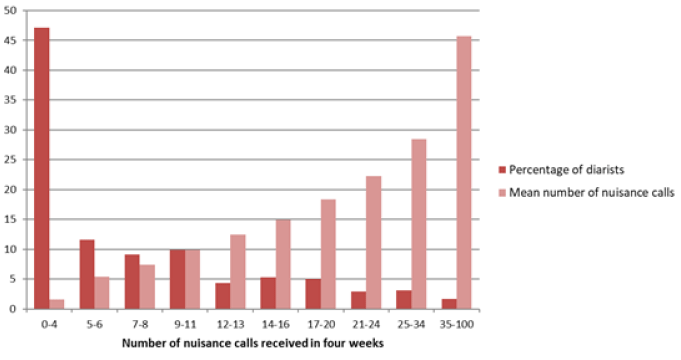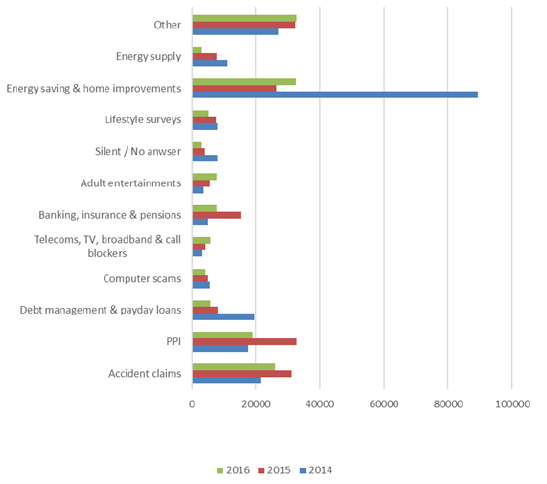Effectiveness of actions to reduce harm from nuisance calls in Scotland
Research commissioned to analyse the impact of actions set out in the Nuisance Calls Commission action plan, and to examine the outcomes of past interventions.
Executive summary
On 11 September 2017, the Scottish Nuisance Calls Commission published its Action Plan. One planned action was:
Measuring impact to make a difference
Volumes of nuisance calls have remained persistently high over the past few years. The Commission identified a need to conduct an in-depth review of previous actions to ensure that future initiatives, at both a Scottish and UK level, are evidence-based and have real potential to make a difference.
We have commissioned research to analyse the impact of the actions set out here and to examine the outcomes of past interventions. This will be shared with the UK Government, regulators, enforcement agencies and consumer groups so that future work is better targeted and more effective.
This report is the main deliverable from that action. It has four main chapters:
2. The situation in the UK, which looks at actions taken in the last few years in the UK to combat nuisance calls, and, drawing on available data, broadly assesses their effectiveness. Actions are grouped by their primary aim:
a. To reduce the level of nuisance calling targeting UK consumers.
b. To prevent nuisance calls targeting UK consumers from reaching them.
c. To minimise harm caused by nuisance calls which do reach UK consumers.
3. The situation in Scotland, which looks at how the situation in Scotland differs from that in the rest of the UK, and broadly assesses the likely effectiveness of actions in the Nuisance Call Action Plan. We carry out detailed analyses of data from Ofcom surveys and trueCall call blockers to compare the levels and kinds of nuisance calls reaching Scottish consumers with those reaching consumers in the rest of the UK, and try to explain the differences that we find. We also identify Scottish organisational arrangements which make it easier (or harder) to combat nuisance calls.
4. Future monitoring of effectiveness of actions, which brings together the data sources already identified and suggests others, to guide the Scottish Government in monitoring the outcomes of its Action Plan.
5. Conclusions and recommendations, which highlights our main findings and recommends additional actions to reduce harm from nuisance calls in Scotland, as well as measurements to enable informed management of all these actions.
The level of nuisance calling into the UK shows no sign of abating in the near future. However, there are now promising new initiatives by some major network operators to suppress nuisance calls within their networks, and also new mobile call management apps, as well as wider availability of call blocking devices. Technical advances of this kind, taken together, could bring a step change in harm reduction from nuisance calls.
Consumer awareness of, and willingness to take up, available protections is crucial to their effectiveness, but both these are relatively low, so actions to support consumer awareness should have high priority. Another approach worth considering is switching network call suppression on by default, at least for certain groups of customers. Nuisance call incidence is very uneven – our analysis of Ofcom research shows that almost half of landline users are barely troubled by nuisance calls but around 8% of landline users receive 30% of all nuisance calls.

The nuisance calls which cause most harm are scam calls. Reliable data on these are lacking, but drawing on various studies of scams we estimate that two-thirds of the £3bn annual harm from scam calls falls on a mere 2% of worst-affected consumers. These are the sort of people whom Trading Standards (especially in Scotland) have been at most pains to provide with call blockers, which are a very effective solution for the limited number of victims who can be reached.
Telephone scams are only one type of fraud, a growing area of criminal activity, to which almost everyone is exposed but some people are especially vulnerable. The Scottish Action Plan includes working on a new Scams Prevention Strategy, which we agree is the right route for protecting people from scams via the phone or any other channel. Often, people who are vulnerable to scams are also vulnerable in other respects, and Scottish systems of care and support for those most at risk, with inter-agency co-operation, could achieve much, if adequately funded.
Relevant regulation has advanced somewhat in recent years, but the two regulators mainly concerned with enforcement against nuisance calls, ICO and Ofcom, are resourced to act against the perpetrators of only a small proportion of offending calls. Regulatory effectiveness could be improved by:
- Streamlining and improving procedures in various respects, aiming to raise the speed and likelihood of potential offenders being pilloried or fined.
- UK implementation in 2018 of the EU General Data Protection Regulation, which may put live voice calls on the same basis as recorded voice calls.
- Greater traceability of nuisance calling through reliable CLI (which should be implemented in the UK in a few years’ time); this will make it harder for miscreants to hide.
However, obscure chains of business relationships, whereby for example a company gathers sales leads on behalf of another company with which it has no direct dealings, cannot be eliminated and will continue to make enforcement in this area very challenging.
When nuisance calls relate to calls in a particular regulated sector, such as PPI or energy provision, sectoral regulators may be better placed than ICO or Ofcom to rule and enforce against inappropriate sales practices.
Our analyses of records of nuisance calling since 2013 show that Scottish consumers have been receiving more nuisance calls than consumers in England, Northern Ireland and Wales, though not consistently more than all other statistical regions of the UK.
Respondents with landline nuisance calls in the previous four weeks, 2014-2017

Source is 21 Ofcom omnibus consumer issues surveys combined. Bars show 99% confidence intervals, with darker shading on more likely parts of bar.
In Scotland, nuisance calls about energy efficiency have continued at a high level (while they fell off elsewhere, as shown below, with the end of Green Deal funding), and greater discipline in this sector could make a real difference. A significant proportion of nuisance calls to Scottish consumers appears to come from Scottish call centres, which offers an opportunity for local action to raise standards.
ICO concerns by sector, 2014-2016

We see the Scottish Action Plan as an excellent initiative which could benefit all parts of the UK, especially if effectiveness findings are shared, and telcos take the opportunity to trial new approaches to nuisance call suppression in Scotland.
Our recommendations on measurements include:
- Integrated and more user-friendly systems for complaints about nuisance calls, so that complaints will better reflect consumer experience.
- Co-ordinated publication of official complaints statistics.
- Ofcom’s Nuisance Calls MoU group of operators to co-operate on producing the best possible indicators of levels of nuisance calls targeting UK consumers.
- Independent verification of industry claims on the effectiveness of their call suppression techniques.
- Future research on consumers’ experience of nuisance calls to cover calls to mobiles in as much detail as calls to landlines.
Additional suggested actions include:
- Routinely including home telephone service and nuisance call protection in needs reviews for people in vulnerable circumstances (for example, when leaving hospital, receiving a dementia diagnosis, or after a fall).
- Setting up a pilot whistleblowing line for Scottish call centre staff, maybe advertising it in Glasgow universities.
- Involving Scottish businesses, especially call centres, and consumers in reviewing and implementing best practices for warm calling, debt collection calls, and calls to consumers in vulnerable circumstances.
Contact
There is a problem
Thanks for your feedback